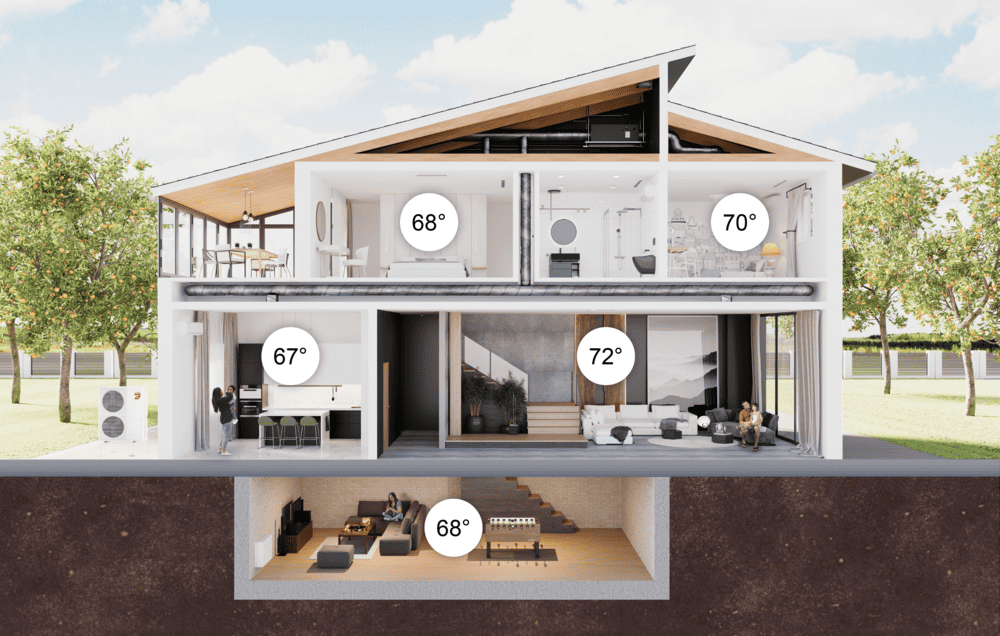Cool and Heat Your Entire Home Efficiently: A Guide to Whole House Mini-Split Systems
Mini-split systems have become increasingly popular as an efficient alternative to traditional central air conditioning systems. These ductless mini split systems offer numerous benefits, including energy savings and zoned comfort control. As more homeowners seek a viable solution for complete home comfort, whole house mini-split systems have emerged as a top choice. This guide will explore everything you need to know about whole house mini split systems, including their functionality, benefits, and factors to consider before installation.
Table of Contents:

Cool and Heat Your Entire Home Efficiently: A Guide to Whole House Mini-Split Systems
A whole house mini split system is a heating and cooling system that consists of an outdoor condenser unit connected to multiple indoor air handling units.
What are Whole House Mini-Split Systems?
A whole house mini split system is a heating and cooling system that consists of an outdoor condenser unit connected to multiple indoor air handling units. Unlike traditional central air conditioning systems that rely on extensive ductwork to distribute conditioned air throughout the home, mini-split systems use refrigerant lines to connect the outdoor unit to each indoor unit. This ductless design allows for targeted temperature control in individual rooms or zones.
GET A PERSONALIZE QUOTE FOR YOUR
DUCTLESS MINI SPLIT SYSTEM TODAY!
Mitsubishi award-winning Diamond Contractor
Serving New York and New Jersey

Benefits of Whole House Mini-Split Systems
1. Energy Efficiency:
- Mini-splits avoid energy loss through leaky ducts, which is common in traditional systems. By delivering conditioned air directly to each room, ductless mini split systems minimize energy waste.
- These systems boast high SEER (Seasonal Energy Efficiency Ratio) ratings, indicating their superior energy efficiency compared to conventional air conditioners.
2. Zoned Comfort:
- With a whole house mini-split system, you can create customized comfort zones throughout your home. Each indoor unit can be controlled independently, allowing you to set different temperatures in different rooms.
- Multi-zone mini-split systems offer the ultimate flexibility, enabling you to heat or cool specific areas of your home as needed, rather than conditioning the entire house unnecessarily.
3. Easy Installation:
- Installing a mini-split system is generally less intrusive and time-consuming than installing a traditional central air system. Since no major ductwork is required, the installation process is simplified.
- The indoor air handlers are connected to the outdoor unit via small refrigerant lines, which can be easily routed through walls or ceilings.
4. Other Benefits:
- Quiet Operation: Mini-splits operate at a lower noise level compared to traditional air conditioners, ensuring a peaceful indoor environment.
- Improved Air Quality: Some mini-split models come equipped with advanced air filtration systems that can remove allergens, dust, and other pollutants from the air.
- Sleek Aesthetics: The indoor units of mini-splits have a modern and unobtrusive design, blending seamlessly with any décor.

Things to Consider Before Installing a Whole House Mini-Split System
1. Climate and Home Size:
- The BTU (British Thermal Unit) capacity of a mini-split system is crucial for effective heating and cooling. It's essential to consider your local climate and the square footage of your home when selecting a system.
- Consult with a professional HVAC technician to determine the appropriate size and capacity for your specific needs.
2. Number of Zones:
- Decide whether a single-zone or multi-zone system best suits your needs. If you have distinct areas in your home with different temperature requirements, a multi-zone system allows for more precise control.
- Consider the layout of your home and the number of rooms or zones you want to condition independently.
3. Professional Installation:
- Proper installation is key to ensuring optimal performance and efficiency of your whole house mini-split system. Hire a qualified HVAC technician with experience in installing ductless systems.
- Attempting a DIY installation or hiring an inexperienced contractor can lead to costly mistakes and reduced system effectiveness.
Cost Considerations
The upfront cost of installing a whole house mini-split system can vary depending on factors such as the size of your home, the number of zones, and the brand and model of the system. On average, expect to invest between $3,000 to $15,000 for a complete installation. While the initial cost may be higher compared to traditional systems, the long-term energy savings can be significant. The increased efficiency of mini-splits often translates to lower utility bills over time, offsetting the upfront investment.
GET A PERSONALIZE QUOTE FOR YOUR
DUCTLESS MINI SPLIT SYSTEM TODAY!
Mitsubishi award-winning Diamond Contractor
Serving New York and New Jersey

Conclusion
Whole house mini-split systems offer a powerful and efficient solution for homeowners seeking a flexible and energy-saving approach to heating and cooling their entire home. With their zoned comfort control, easy installation, and quiet operation, mini-splits provide a compelling alternative to traditional central air conditioning systems. If you're considering a whole house mini split system for your home, consult with a reputable HVAC professional to assess your specific needs and receive a personalized recommendation. By investing in a ductless mini split system, you can enjoy a comfortable, energy-efficient living space while potentially lowering your energy bills in the long run.
TL;DR
- A whole house mini split system is a ductless heating and cooling system that offers targeted temperature control in individual rooms or zones.
- Mini-splits are highly energy efficient, avoiding energy loss through leaky ducts and boasting high SEER ratings.
- Zoned comfort control allows for customized temperature settings in different areas of the home.
- Installation is generally easier compared to traditional central air systems, as no major ductwork is required.
- Consider factors such as climate, home size, number of zones, and professional installation when planning for a whole house mini-split system.
- While the upfront cost may be higher, long-term energy savings can offset the initial investment.
Back Home - Richair Comfort Solution - Ductless Mini Split Systems Top Quality Installations and Professional Service.
Was This Article Helpful?
RECENT POSTS

